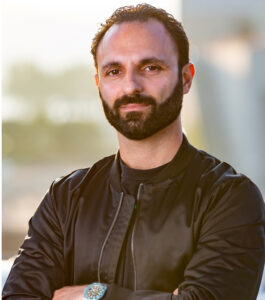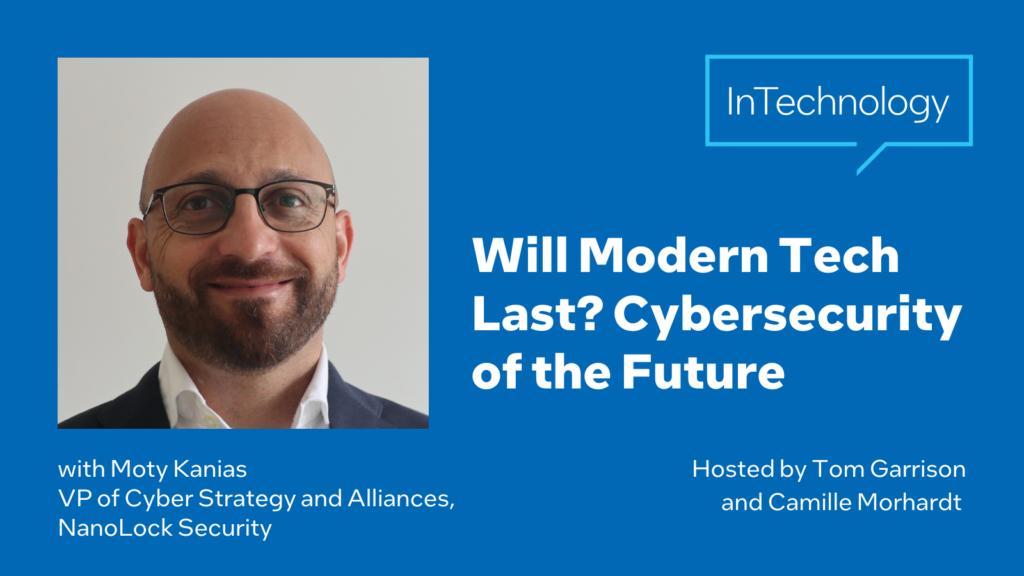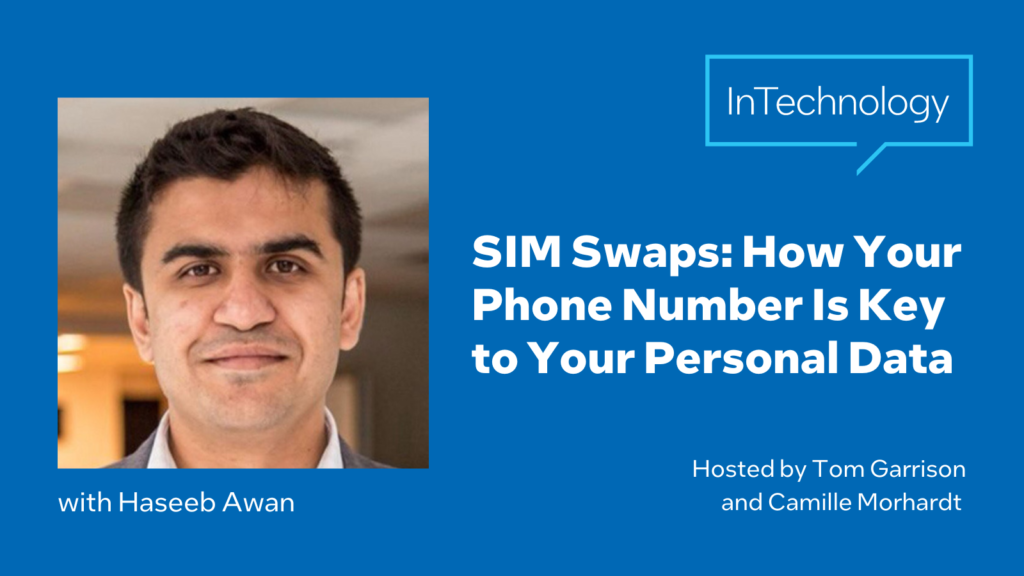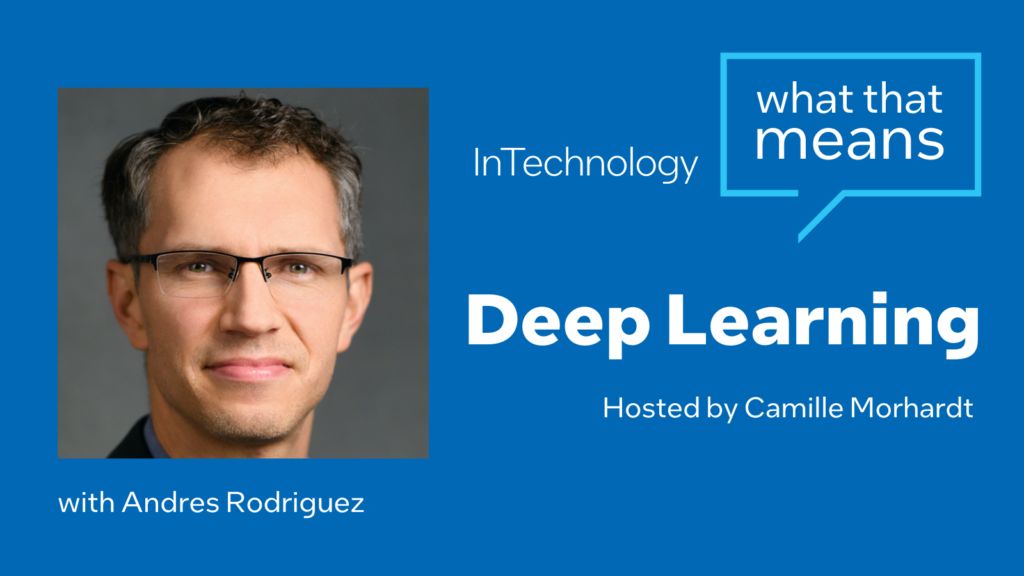[00:00:36] Camille Morhardt: Hello and welcome to InTechnology podcast. Today I have Ardy Arianpour on from Seqster, and I’m gonna let him define what the company does. But we are gonna be focused on digital health and personalized medicine or precision medicine, and Artie can help us understand the difference and similarity between the two. Welcome, Ardy.
[00:00:56] Ardy Arianpour: Thanks so much, Camille, for having me here.
[00:00:58] Camille Morhardt: So I’m gonna let you describe Seqster. I know you work y you’re part of sort of digital health and unlocking data and de-siloing data in the digital health space. Can you tell us a little bit more about what the company does?
[00:01:12] Ardy Arianpour: Sure. Seqster’s a healthcare technology company where we’ve pioneered the longitudinal health record for patients. We put the patient at the center of healthcare in order to disrupt or break down the silos, as you mentioned from EMR/EHR data, to your baseline genetic genomic data, to your wearable medical device, remote patient monitoring data. And we’re not limited to just those data sources. We’ve built an interoperability technology and a data refinery engine that hits on the intersection of technology and healthcare. It’s an operating system for healthcare.
[00:01:58] Camille Morhardt: Okay, so an EMR/ EHR, electronic medical record, electronic health record, if anybody’s not familiar.
So it used to be that, you know, you go to the doctor’s office or the hospital and if you needed any kind of lab test or you needed one specialist weighing in on another specialist or back and forth between primary care, it was like, FAX this piece of paper over here, or “I’m sorry, I have to retake the X-ray because I can’t trust the X-ray from the other place” or “it can’t really come in transit at the quality that I need it to. And now, not only are we looking at a time when those things can be transmitted efficiently, digitally, but we’re also adding on this concept of like remote monitoring.
Can you just lay that foundation rather than how you’re tackling it specifically, but what are all of the different ways that medical data can be collected digitally and transferred digitally today?
[00:02:54] Ardy Arianpour: I would first start off with just the foundation of data itself. There’s various different EMRs or electronic medical record systems or EHRs, electronic health record systems such as Epic, Allscripts–there’s about 28 major ones in the United States. And one reason why our healthcare is so fragmented is because those systems don’t actually talk to one another.
And so, you know, when you’re a patient or you are a physician or clinician and you’re trying to deal with care coordination, it’s very hard to get data from one system to another system if you’re moving across the country or going to a specialist for the first time or whatever that scenario or intervention might be on the medical side. But more importantly, there was something that was passed called HIPAA. And HIPAA is a law that the “P” within HIPAA stands for portability, but they never actually the data portable.
So what Seqster did out in 2016 when we founded the company, we had this, you know, idea of bringing together all of your health records from one place, all of your DNA data from another place, all of your medical device data or your Garmin watch and your Apple watch data that don’t talk to one another because of that same interoperability issue into one place and visualize that data for the patient and caregiver.
[00:04:43] Camille Morhardt: So did the systems not talk to each other because. They had some sort of incentive not to because they were trying to keep the records separate, or did they not talk just because they were doing their own thing and there was no special incentive to talk to each other?
[00:04:58] Ardy Arianpour: Yeah, that’s a really good question. Um, I think the best way to answer that from our standpoint is, one, it’s a really hard problem; so I wouldn’t really blame anyone for it. It just kind of happened. When the High Tech Act was passed years ago and records started being digitized, patient portals were being made so that you can pay your bill and things like that. Every single health system operates as a business entity on their own. I wouldn’t say it was on purpose. The health systems did not go above and beyond to collaborate to make it easier for patients. And that’s why in the US we have this interoperability issue where McKinsey, the big consulting company, has estimated, from just, uh, 2018 or 2019 was the last time I saw the numbers, they calling it anywhere between a $35 to $40 billion ballooning annual problem for healthcare. Right. I think it’s, it’s much higher than that. I don’t know what the current figures are, but that’s because, you know, there’s been hundreds of medical devices that have been launched in the last decade. There’s been wearables that have been launched. Those things don’t even talk together. There’s new medical practices, doctor clinics, dermatology offices, optometry offices that don’t talk to the health system. It’s very fragmented.
[00:06:33] Camille Morhardt: But how are you getting the information then? Like are they providing APIs for you? or how are you actually gathering it and putting it in one dashboard?
[00:06:43] Ardy Arianpour: Yeah. So what government did from the Office of ONC and CMS and Health Human Services, they set out a law called the 21st Century Cures Act. That law allows patient access rights. Seqster was the concepts used for those 21st Century Act law. And in 2016, when we founded the company, Camille, we never thought that Seqster would’ve been law. That’s not what, why we founded it. We fell on this accident on interoperability and just started grinding and doing what I call the dirty engineering that no one really wanted to do. And, um, if you want to visualize data, you have to be able to standardize that data on the back end; you can’t have Stanford data, Memorial Sloan Kettering data, Cleveland Clinic data, NYU data altogether if that data’s not standardized. So how we do it is through the patient, put the patient at the center.
[00:07:52] Camille Morhardt: So what do you mean the patient’s at the center? If I’m the patient, I’m looking at all of my different records and then I get to decide where I send them? Is that the…
[00:08:00] Ardy Arianpour: You have complete control, complete ownership, and complete sharing accessibility for your information.
[00:08:11] Camille Morhardt: So Ardy, if I’m a patient and I’m accessing my dashboard through a portal or something, does this cost me anything?
[00:08:19] Ardy Arianpour: Doesn’t cost you money. How do we make money is probably the better question. It’s subsidized. For example, if you go to T-Mobile, you don’t have to go pay for a new iPhone. They’ll give you a new iPhone for free, but you gotta sign a two-year contract with T-Mobile or Verizon or whatever it may be, right?
With us, let’s say we have a deal with Pfizer. Let’s say we have a deal with Nova Nordisk. Let’s say we have a deal with whoever Coca-Cola for their employees. You get it through them. However, when I first started, we built the direct-to-consumer application and we pivoted after Bill Gates actually called me and he told me, “you guys have an operating system. This isn’t a platform.”
You know, after that, we pivoted to the Seqster OS and we built this operating system. But you can try it yourself. If you go on your desktop and go to app.Seqster. It’s completely free. Never charged. You can even go check it out. You don’t even need to connect any data. But if you do, you know, you can see what it looks like.
[00:09:25] Camille Morhardt: So I wanna look at sort of, well, at least what I would consider for many people would be kind of the scary side of what you’re talking about when you’re starting to talk about. Collecting data even while I sleep, or looking for like heart arrhythmias or even like ergonomic tracking kinds of data that could be collected through what I’m doing on my PC–even if I have control over it, it’s being gathered, it’s being aggregated, and then there’s a potential for that to be shared across health providers, across technology companies, across maybe even insurance.
Are concerns legitimate? Are they rational? And What kinds of things are being done in general? I mean, it doesn’t necessarily have to be Seqster, but just in general, like what kinds of ways are we protecting that type of data?
[00:10:17] Ardy Arianpour: So a couple things. Um, that’s a, that’s super valid. What you bring in privacy and security are of concern and it was also a heavy investment that we made at the beginning. So you probably heard of certain breaches within healthcare systems, right? There’s certain breaches of data that happen and one reason why that happens, I’ll give you an example: Kaiser being one of our biggest healthcare systems in the United States, in the state of California, has around 11.7 million patients. They have one encryption code for all those 11.7 million patients. So if there’s a breach, there’s access to a vast majority of the data. And it’s not just Kaiser, that’s any health system; whether that’s a health system that’s 100,00 people, or if it’s MD Anderson that has a million people about, they all have this problem because how they were built from the beginning. Even if they want to change it, they’re not gonna just shut down their practice and shut down the EMRs and then launch a whole new thing. And I’ll tell you why. The best way to actually encrypt data is the moment of collection.
We’ve built and we’ve improved and progressed on the encryption. We have 256 bit encryption. We have bank-level security there, and more importantly, if you have one patient or 11.7 million patients like Kaiser, you have one encryption identifier for that one patient, or 11.7 million different types of encryptions. Because the moment of collection happens at the patient level.
Now, you can’t expect health systems to take the same exact stance, because they’re not really direct to consumer. They’re a provider. They’re a health system, so their business is different. But for our technology and our model, how we made it more secure says something about where technology is headed.
[00:12:35] Camille Morhardt: So the companies that are supporting you, then the pharma, big pharma, for example, you listed off, how are they benefiting from it?
[00:12:42] Ardy Arianpour: They’re using it as a patient engagement tool for all their clinical trials to advance precision medicine, to advance personalized medicine, to advance drug developments. So the patient gets something back within the trial, meaning they get to track and monitor their health data and the patient gets to give consented data to that trial.
[00:13:10] Camille Morhardt: So are you envisioning in the future running some kind of an AI model off of your own private dashboard? Is the ultimate goal, kind of this predictive medicine or just health monitoring, and are you going to use AI to kind of look for patterns and trends?
[00:13:30] Ardy Arianpour: We are definitely interested in doing the right things with AI. There’s a lot that can be done within healthcare because of physician burnout, patient burnout and just finding certain things that you couldn’t find before. There are current examples such as, when you go get a colonoscopy, there’s a live, A GI doc looking at your colon and they can miss things. But now with AI at the tip of the marker that is trying to find the scans, AI might find something that that person missed with the naked eye. That’s a great example of AI in medicine. And the reason being is because they’re able to layer that AI on top of the data.
This is happening also, um, for breast cancer and breast screenings. But you know, when you’re looking at the data, the more data you have, the more you can pump out, the more analytics and AI becomes more valuable.
[00:14:36] Camille Morhardt: So there’s been kind of a trend or a little bit of a trend toward AI using distributed models in the healthcare space, like federated learning, where we can say, “okay, hey, patient data can remain, you know, literally in the hospital where it was collected through that imaging system. And then we’ll use aggregators and go train central models. But your data, your raw data, health data never leaves, never goes into the cloud.” And people cite that as a security priority.
So it sounds to me like you’re talking about the opposite, where you are aggregating all of this data, the raw data is leaving the places where it was collected, either your wrist, um, or, or the hospital or the genome lab.
So talk to me about, do you think that- which model is gonna prevail? Or will it, will it depend on the use case, or will they both grow?
[00:15:30] Ardy Arianpour: I do think that it’s the latter. 100%, not even 99%. It’s dependent on the use case. It’s dependent on the disease. It’s dependent on the patient, it’s dependent on the caregiver. Now is that gonna change in the near future? I don’t see that changing. From our experience, it’s completely dependent on the use case.
[00:15:54] Camille Morhardt: What use cases do you think will remain distributed or federated in which would be aggregated? Is it like disease versus health or you know, longitudinal tracking versus some other kind of a thing? Is there like a general
[00:16:07 ] Ardy Arianpour: Yeah. Longitudinal data tracking, post-market surveillance studies within clinical trials.
[00:16:14] Camille Morhardt: What’s that?
[00:16:15] Ardy Arianpour: Let’s say you’re on HUMIRA. And there’s another drug by Takeda called Entyvio, and your physician changes your drug for whatever reason–maybe cuz it has better efficacy. Maybe cuz it’s better personalized for you because now we have all this data and we can make better decisions based off the person, not just off of a pharma company selling us a brand name. Right? That can’t really be unless you actually have a 360-degree view of a patient.
And when you aggregate this data for multiple different sources, for multiple different providers that you’ve had within your care journey or patient journey, the intervention becomes a lot easier; it becomes a lot more clear and decisions can be made a lot quicker, too.
I stand by the saying of “health data is medicine.” I believe and we believe it Seqster (cuz we’ve seen it firsthand with our technology saving people’s lives) because we were able to run a tumor board in six hours and get a patient into surgery within less than a week, and then they were able to remove that tumor out of their ascending colon and dodge cancer being metastasized.
Health data is medicine because of certain examples like that, and we see that across different use cases. For sure on oncology. It gets really complicated when you’re going into dementia and Alzheimer’s, and that’s another big segment in the US that’s I think is gonna be the most growing disease in the next two, three decades because of our aging population. And there’s a lot of silver tech, they call it, that’s trying to solve those problems. But what they’re forgetting is how do you get all the data in a common form?
I had personally two grandmothers that passed away due to Alzheimer’s disease. What if I was able to share my data with your family? We’re not related, but maybe my data can help your family because you guys might be going through the same patient journeys, caregiver journeys. So all this defragmentation of healthcare really affects a domino effect around not just patients and, and the home, but overall the wellbeing of our country.
[00:18:53] Camille Morhardt: I do have another question that’s kind of related to access. So for people who are distrustful of big tech or big pharma, what kind of guarantees do they have that they still have top access to healthcare? Even if they’re not interested in having their records aggregated or shared?
[00:19:11] Ardy Arianpour: You can use it still and consent not to share. It doesn’t need to be shared. So that’s where the digital consent that we built within the system comes in handy. We built that engine where we plug into any enterprise as a white label, and the consented data is what’s being used and shared in a de-identified way.
[00:19:39] Camille Morhardt: Okay. Yeah, true. I think we probably should have noted that before. Even if you’re sharing information, it’s been anonymized or it’s been de-identified in such a way as it can’t be associated with you, the individual, you associated with your name. Good point.
[00:19:55] Ardy Arianpour: Yeah. All the data is de-identified and all the data is encrypted.
[00:20:00] Camille Morhardt: So do you think that there’s a future for if I have sovereignty over my own data–even if a platform is collecting it or aggregating it for me–is there a space where I can monetize that my own self? Like if there’s whatever kind of health company is interested in, in using that for some broader study or something sort of on the table? Or is that being quickly constructed so that the individual patient would never have that opportunity?
[00:20:32] Ardy Arianpour: Yeah, so number one, we very strong feelings around this. And when we started Seqster, we wanted it to be all about consented data, number one. So you own the data. We don’t own it. There’s been lots of different talks and we’ve had ideas around a marketplace for health data so that folks like my mom, who’s a breast cancer survivor, could donate her data and get paid for her data. But how would she actually do that? Who’s the broker? How is she gonna collect her data? How is she gonna be able to even know about some sort of thing like this? And so there’s a lot of education there on that. There could be an enormous opportunity around this.
I think what’s really interesting is that everyone’s kind of thinking about this around their health data, and the reason being is because they know that it’s personable and they know that it’s valuable. You don’t really think about that when you’re sharing your pictures on Instagram or your posts on LinkedIn because how valuable is it? Maybe it’s worth pennies or, I don’t know, maybe dollars, but your health date is actually worth a lot. It costs $168,000 to keep someone in a clinical.
[00:21:50] Camille Morhardt: Thank you Ardy Arianpour, CEO and co-founder of Seqster. I really appreciate your insight today into digital health. Personally, I’m looking forward to more and more conversations about the intersection between biology and healthcare and technology. I think that this is really leading edge, cutting edge stuff that also comes with a certain amount of apprehension. And, uh, ethics and privacy considerations. So I really wanna make sure we carefully go through some of these conversations. Appreciate your insight today and your opinion. Ardy,
[00:22:25] Ardy Arianpour: Thanks so much, Camille, for having me here.




